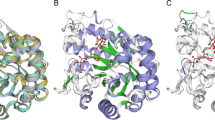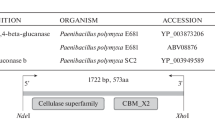Abstract
Levoglucosan, cellulosic pyrolysate, is converted to glucose-6-phosphate by a specific levoglucosan kinase in fungi. A novel cDNA of levoglucosan kinase gene (lgk) from yeast Lipomyces starkeyi YZ-215 was isolated by RACE method. The 1,445 bp cDNA fragment (lgk) harbouring the kinase gene exhibited one open reading frame (ORF) composed of 1,317 bp flanked by a 14 bp 5′-UTR and a 114 bp 3′-UTR, including a 25 bp poly(A) tail. The ORF encoded a 439 amino acid polypeptide with a 48.4 kDa predicted molecular mass. Analysis of amino sequence revealed that the kinase belonged to the bacterial anhydro-N-acetylmuramic acid kinase (AnmK) family, and kinase-like proteins existed in some fungi, especially in filamentous fungi such as Aspergillus. The kinase gene was transformed into Escherichia coli BL21 (DE3), recombinant E. coli could grow in M9 minimal medium with levoglucosan as a sole carbon source when induced by IPTG. In addition, the recombinant kinase was overexpressed, purified and characterized. The kinase was stable at pH 7–10 and showed maximum activity at 30°C and pH 9.0 as natural kinase, but presented higher thermostability. Kinetic constants (apparent K m values) for LG and ATP were 105.3 ± 12.5 and 0.20 ± 0.02 mM, respectively. Furthermore, the kinase showed substrate specificity for LG. This novel levoglucosan kinase gene would be useful in constructing recombinant microbial strains for the efficient bioconversion of cellulosic pyrolysate to ethanol.





Similar content being viewed by others
Notes
The K m value of natural LGK for ATP was 0.68 mM by Ning et al. (2008). We measured it again and affirmed that it was 0.20 mM.
References
Adams A, Gottschling DE, Kaiser CA, Stearns T (2001) Methods in yeast genetics: a cold spring harbour laboratory course manual. Cold Spring Harbor Laboratory Press, NY
Brown RC, Radlein D, Piskorz J (2001) Pretreatment processes to increase pyrolytic yield of levoglucosan from herbaceous feedstocks. In: Bosell JJ (ed) Chemicals and materials from renewable resources. American Chemical Society, Washington, DC, pp 123–134
Farrell AE, Plevin RJ, Turner BT, Jones AD, O’Hare M, Kammen DM (2006) Ethanol can contribute to energy and environmental goals. Science 311:506–508
Gao S, Hegg DA, Hobbs PV, Kirchstetter TW, Magi BI, Sadilek M (2003) Water-soluble organic components in aerosols associated with savanna fires in southern Africa: identification, evolution, and distribution. J Geophys Res 108:8491–8506
Kitamura Y, Yasui T (1991) Purification and some properties of levoglucosan (1,6-anhydro-β-d-glucopyranose) kinase from the yeast Sporobolomyces salmonicolor. Agric Biol Chem 55:523–529
Kitamura Y, Abe Y, Yasui T (1991) Metabolism of levoglucosan (1,6-anhydro-β-d-glucopyranose) in microorganisms. Agric Biol Chem 55:515–521
Nakagawa M, Sakai Y, Yasui T (1984) Itaconic acid fermentation of levoglucosan. J Ferment Technol 62:201–203
Nakahara K, Kitamura Y, Yamagishi Y, Shoun H, Yasui T (1994) Levoglucosan dehydrogenase involved in the assimination of levoglucosan in Arthrobacter sp. I-552. Biosci Biotechnol Biochem 58:2193–2196
Ning J, Yu Z, Xie H, Zhang H, Zhang G, Bai Z, Yang S, Jiang Y (2008) Purification and characterization of levoglucosan kinase from Lipomyces starkeyi YZ-215. World J Microbiol Biotechnol 24:15–22
Prosen EM, Radlein D, Piskorz J, Scott DS, Legge RL (1993) Microbial utilization of levoglucosan in wood pyrolysate as a carbon and energy source. Biotechnol Bioeng 42:538–541
Sambrook J, Russell DW (2001) Molecular cloning: a laboratory manual, 3rd edn. Cold Spring Harbor Laboratory Press, NY
Schauer JJ, Kleeman MJ, Cass GR, Simoneit BRT (2001) Measurement of emissions from air pollution sources. 3. C1–C29 organic compounds from fireplace combustion of wood. Environ Sci Technol 35:1716–1728
Thompson JD, Gibson TJ, Plewniak F, Jeanmougin F, Higgins DG (1997) The clustalX windows interface: flexible strategies for multiple sequence alignment aided by quality analysis tools. Nucleic Acids Res 25:4876–4882
Uehara T, Suefuji K, Valbuena N, Meehan B, Donegan M, Park JT (2005) Recycling of the anhydro-N-acetylmuramic acid derived from cell wall murein involves a two-step conversion to N-acetylglucosamine-phosphate. J Bacteriol 187:3643–3649
Waltz E (2008) Cellulosic ethanol booms despite unproven business models. Nat Biotechnol 26:8–9
Xie H, Zhuang X, Zhang H, Bai Z, Qi H (2005) Screening and identification of the levoglucosan kinase gene (lgk) from Aspergillus niger by LC-ESI-MS/MS and RT-PCR. FEMS Microbiol Lett 251:313–319
Xie H, Zhuang X, Bai Z, Qi H, Zhang H (2006) Isolation of levoglucosan-assimilating microorganisms from soil and an investigation of their levoglucosan kinases. World J Microbiol Biotechnol 22:887–892
Yu Z (2003) Fermentation of cellulosic pyrolysis products to ethanol and its construction of cell engineering strain. Dissertation, Graduate University of the Chinese Academy of Sciences
Yu Z, Zhang H (2003) Ethanol fermentation of acid-hydrolyzed cellulosic pyrolysate with Saccharomyces cerevisiae. Bioresour Technol 90:95–100
Zhuang X, Zhang H (2002) Identification, characterization of levoglucosan kinase, and cloning and expression of levoglucosan kinase cDNA from Aspergillus niger CBX-209 in Escherichia coli. Protein Express Purific 26:71–81
Zhuang XL, Zhang HX, Tang JJ (2001) Levoglucosan kinase involved in citric acid fermentation by Aspergillus niger CBX-209 using levoglucosan as sole carbon and energy source. Biomass Bioenergy 21:53–60
Acknowledgments
This work was supported by the National Science Foundation of China (No. 20507021 and No. 40603024) and in part by the President Fund of GUCAS (No. M3018). We are grateful to Professor Dr. James T. Park (Tufts University, USA) for his generous present: E. coli BL21 (DE3)/pTanmK, and helpful private communications.
Author information
Authors and Affiliations
Corresponding author
Rights and permissions
About this article
Cite this article
Dai, J., Yu, Z., He, Y. et al. Cloning of a novel levoglucosan kinase gene from Lipomyces starkeyi and its expression in Escherichia coli . World J Microbiol Biotechnol 25, 1589–1595 (2009). https://doi.org/10.1007/s11274-009-0048-9
Received:
Accepted:
Published:
Issue Date:
DOI: https://doi.org/10.1007/s11274-009-0048-9




